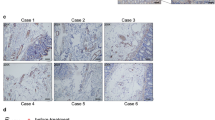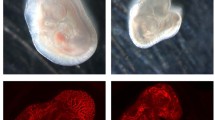Abstract
Background
Thalidomide is effective in the treatment of angiodysplasia. The mechanisms underlying its activity may be associated with inhibition of angiogenic factors. It was recently shown that Slit2/Robo1 signaling plays a role in angiogenesis.
Purpose
The aim of this study was to explore the expression and effects of Robo1 and Slit2 in angiodysplasia and to identify the possible therapeutic mechanisms of thalidomide.
Method
Slit2 and Robo1 expression were analyzed in tissue samples and human umbilical vein endothelial cells (HUVECs) treated with thalidomide using a combination of laboratory assays that were able to detect functional activity.
Results
Slit2, Robo1 and vascular endothelial growth factor (VEGF) were strongly expressed in five angiodysplasia lesions out of seven cases, while expression was low in one out of seven normal tissues. Exposure of HUVECs to recombinant N-Slit2 resulted in an increase in VEGF levels and stimulated proliferation, migration and tube formation. These effects were blocked by an inhibitor of PI3K and thalidomide.
Conclusions
Robo1 and Slit2 may have important roles in the formation of gastrointestinal vascular malformation. High concentrations of Slit2 increased the levels of VEGF in HUVECs via signaling through the PI3K/Akt pathway—an effect that could be inhibited by thalidomide.






Similar content being viewed by others
References
Regula J, Wronska E, Pachlewski J. Vascular lesions of the gastrointestinal tract. Best Pract Res Clin Gastroenterol. 2008;22:313–328.
Junquera F, Saperas E, de Torres I, Vidal MT, Malagelada JR. Increased expression of angiogenic factors in human colonic angiodysplasia. Am J Gastroenterol. 1999;94:1070–1076.
Paul JD, Coulombe KL, Toth PT, et al. SLIT3-ROBO4 activation promotes vascular network formation in human engineered tissue and angiogenesis in vivo. J Mol Cell Cardiol. 2013;64:124–131.
Guo SW, Zheng Y, Lu Y, et al. Slit2 overexpression results in increased microvessel density and lesion size in mice with induced endometriosis. Reprod Sci. 2013;20:285–298.
Brose K, Bland KS, Wang KH, et al. Slit proteins bind Robo receptors and have an evolutionarily conserved role in repulsive axon guidance. Cell. 1999;96:795–806.
Wong K, Park HT, Wu JY, Rao Y. Slit proteins: molecular guidance cues for cells ranging from neurons to leukocytes. Curr Opin Genet Dev. 2002;12:583–591.
Kramer SG, Kidd T, Simpson JH, Goodman CS. Switching repulsion to attraction: changing responses to slit during transition in mesoderm migration. Science. 2001;292:737–740.
Adams RH, Eichmann A. Axon guidance molecules in vascular patterning. Cold Spring Harb Perspect Biol. 2010;2:a001875.
Sheldon H, Andre M, Legg JA, et al. Active involvement of Robo1 and Robo4 in filopodia formation and endothelial cell motility mediated via WASP and other actin nucleation-promoting factors. FASEB J. 2009;23:513–522.
Urbich C, Rössig L, Kaluza D, et al. HDAC5 is a repressor of angiogenesis and determines the angiogenic gene expression pattern of endothelial cells. Blood. 2009;113:5669–5679.
Wang B, Xiao Y, Ding BB, et al. Induction of tumor angiogenesis by Slit-Robo signaling and inhibition of cancer growth by blocking Robo activity. Cancer Cell. 2003;4:19–29.
Zhou W, Yu W, Xie W, et al. The role of SLIT-ROBO signaling in proliferative diabeticretinopathy and retinal pigment epithelial cells. Molecular Vision. 2011;17:1526–1536.
Liao WX, Laurent LC, Agent S, Hodges J, Chen DB. Human placental expression of Slit/ROBO signaling cues: effects of preeclampsia and hypoxia. Biol Reprod. 2012;86:111.
Zhou W, Yu W, Xie W, Huang L, Xu Y, Li X. The role of Slit-ROBO signaling in proliferative diabetic retinopathy and retinal pigment epithelial cells. Mol Vis. 2011;17:1526–1536.
Yang XM, Han HX, Sui F, Dai YM, Chen M, Geng JG. Slit-Robo signaling mediates lymphangiogenesis and promotes tumor lymphatic metastasis. Biochem Biophys Res Commun. 2010;396:571–577.
Bartlett JB, Dredge K, Dalgleish AG. The evolution of thalidomide and its IMiD derivatives as anticancer agents. Nat Rev Cancer. 2004;4:314–322.
Danese S, Sans M, Spencer DM, et al. Angiogenesis blockade as a new therapeutic approach to experimental colitis. Gut. 2007;56:855–862.
Ge ZZ, Chen HM, Gao YJ, et al. Long-term effects of thalidomide for recurrent gastrointestinal bleeding due to vascular malformation: an open-label, randomized, parallel controlled study. Gastroenterology. 2011;141:1629–1637.
Lebrin F, Srun S, Raymond K, et al. Thalidomide stimulates vessel maturation and reduces epistaxis in individuals with hereditary hemorrhagic telangiectasia. Nat Med. 2010;16:420–428.
Regula J, Wronska E, Pachlewski J. Vascular lesions of the gastrointestinal tract. Best Pract Res Clin Gastroenterol. 2008;22:313–328.
Tan H, Chen H, Xu C, et al. Role of vascular endothelial growth factor in angiodysplasia: an interventional study with thalidomide. J Gastroenterol Hepatol. 2012;27:1094–1101.
Chavakis E, Dernbach E, Hermann C, Mondorf UF, Zeiher AM, Dimmeler S. Oxidized LDL inhibits vascular endothelial growth factor-induced endothelial cell migration by an inhibitory effect on the Akt/endothelial nitric oxide synthase pathway. Circulation. 2001;103:2102–2103.
Fujio Y, Walsh K. Akt mediates cytoprotection of endothelial cells by vascular endothelial growth factor in an anchorage-dependent manner. J Biol Chem. 1999;274:16349–16354.
Nakamura JL, Karlsson A, Arvold ND, et al. PKB/Akt mediates radiosensitization by the signaling inhibitor LY294002 in human malignant gliomas. J Neurooncol. 2005;71:215–222.
Benedito R, Roca C, Sörensen I, et al. The notch ligands Dll4 and Jagged1 have opposing effects on angiogenesis. Cell.. 2009;137:1124–1135.
Larrivée B, Prahst C, Gordon E, et al. ALK1 signaling inhibits angiogenesis by cooperating with the Notch pathway. Dev Cell. 2012;22:489–500.
Hernandez SL, Banerjee D, Garcia A, et al. Notch and VEGF pathways play distinct but complementary roles in tumor angiogenesis. Vasc Cell. 2013;5:17.
Zhu Y, Lee C, Shen F, Du R, Young WL, Yang GY. Angiopoietin-2 facilitates vascular endothelial growth factor-induced angiogenesis in mature mouse brain. Stroke. 2005;36:1533–1537.
Loukovaara S, Robciuc A, Holopainen JM. Ang-2 upregulation correlates with increased levels of MMP-9, VEGF, EPO and TGFβ1 in diabetic eyes undergoing vitrectomy. Acta Ophthalmol. 2013;91:513–519.
Saunders WB, Bohnsack BL, Faske JB, et al. Coregulation of vascular tube stabilization by endothelial cell TIMP-2 and pericyte TIMP-3. J Cell Biol. 2006;175:179–191.
Knobloch J, Schmitz I, Götz K, Schulze-Osthoff K, Rüther U. Thalidomide induces limb anomalies by PTEN stabilization, Akt suppression, and stimulation of caspase-dependent cell death. Mol Cell Biol. 2008;28:529–538.
Therapontos C, Erskine L, Gardner ER, Figg WD, Vargesson N. Thalidomide induces limb defects by preventing angiogenic outgrowth during early limb formation. Proc Natl Acad Sci USA. 2009;106:8573–8578.
Dredge K, Horsfall R, Robinson SP, et al. Orally administered lenalidomide (CC-5013) is anti-angiogenic in vivo and inhibits endothelial cell migration and Akt phosphorylation in vitro. Microvas Res. 2005;69:59–63.
Terpos E, Kanellias N, Christoulas D, Kastritis D, Dimopoulos MA. Pomalidomide: a novel drug to treat relapsed and refractory multiple myeloma. Onco Targets Ther. 2013;6:531–538.
Dredge K, Marriott JB, Macdonald CD, et al. Novel thalidomide analogues display anti-angiogenic activity independently of immunomodulatory effects. Br J Cancer. 2002;87:1166–1172.
Acknowledgments
The research presented here was funded by the Shanghai Municipal Health Bureau Academic Discipline Project, Project Number: 20114002.
Conflict of interest
The authors declare that they have no conflict of interest.
Author information
Authors and Affiliations
Corresponding author
Rights and permissions
About this article
Cite this article
Li, Y., Fu, S., Chen, H. et al. Inhibition of Endothelial Slit2/Robo1 Signaling by Thalidomide Restrains Angiogenesis by Blocking the PI3K/Akt Pathway. Dig Dis Sci 59, 2958–2966 (2014). https://doi.org/10.1007/s10620-014-3257-5
Received:
Accepted:
Published:
Issue Date:
DOI: https://doi.org/10.1007/s10620-014-3257-5




